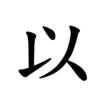以
| ||||||||
Translingual
| Stroke order | |||
|---|---|---|---|
| Stroke order | |||
|---|---|---|---|
 | |||
Han character
以 (radical 9, 人+2 in Chinese, 人+3 in Japanese, 4 strokes in Chinese, 5 strokes in Japanese, cangjie input 女戈人 (VIO), four-corner 28100, composition ⿲𠄌丶人)
Descendants
- い (Hiragana character derived from Man'yōgana)
- 𛀆
References
- KangXi: page 94, character 1
- Dai Kanwa Jiten: character 388
- Dae Jaweon: page 199, character 1
- Hanyu Da Zidian: volume 1, page 105, character 7
- Unihan data for U+4EE5
Chinese
| simp. and trad. |
以 | |
|---|---|---|
| variant forms | 㠯 | |
Glyph origin
| Historical forms of the character 以 | |||||||||||||||||||||||||||||||||||||||||||||||||||||||||||||||||||||||||||||||||||||||||||||||||||||||||||||
|---|---|---|---|---|---|---|---|---|---|---|---|---|---|---|---|---|---|---|---|---|---|---|---|---|---|---|---|---|---|---|---|---|---|---|---|---|---|---|---|---|---|---|---|---|---|---|---|---|---|---|---|---|---|---|---|---|---|---|---|---|---|---|---|---|---|---|---|---|---|---|---|---|---|---|---|---|---|---|---|---|---|---|---|---|---|---|---|---|---|---|---|---|---|---|---|---|---|---|---|---|---|---|---|---|---|---|---|---|---|
| Shang | Western Zhou | Shuowen Jiezi (compiled in Han) | Liushutong (compiled in Ming) | ||||||||||||||||||||||||||||||||||||||||||||||||||||||||||||||||||||||||||||||||||||||||||||||||||||||||||
| Oracle bone script | Bronze inscriptions | Small seal script | Transcribed ancient scripts | ||||||||||||||||||||||||||||||||||||||||||||||||||||||||||||||||||||||||||||||||||||||||||||||||||||||||||
 |
 |
 |
 | ||||||||||||||||||||||||||||||||||||||||||||||||||||||||||||||||||||||||||||||||||||||||||||||||||||||||||
| |||||||||||||||||||||||||||||||||||||||||||||||||||||||||||||||||||||||||||||||||||||||||||||||||||||||||||||
|
References: Mostly from Richard Sears' Chinese Etymology site (authorisation),
| |||||||||||||||||||||||||||||||||||||||||||||||||||||||||||||||||||||||||||||||||||||||||||||||||||||||||||||
| Characters in the same phonetic series (以) (Zhengzhang, 2003) | |
|---|---|
| Old Chinese | |
| 似 | *ljɯʔ |
| 姒 | *ljɯʔ |
| 耜 | *ljɯʔ |
| 佀 | *ljɯʔ |
| 以 | *lɯʔ |
| 苡 | *lɯʔ |
| 苢 | *lɯʔ |
Originally 㠯. The current glyph has a 人 (“human”) added on the right side.
The glyph origin of 㠯 is uncertain.
Etymology 1
From Proto-Sino-Tibetan *la-k (“to take; to fetch”) (Schuessler, 2007; STEDT).
Pronunciation
Definitions
以
- a preposition that expresses a boundary in spacetime or bearing (e.g., see 以北 (yǐběi), 以東/以东 (yǐdōng), 以後/以后 (yǐhòu), 以來/以来 (yǐlái), 以南 (yǐnán), 以內/以内 (yǐnèi), 以前 (yǐqián), 以上 (yǐshàng), 以外 (yǐwài), 以往 (yǐwǎng) 以西 (yǐxī), 以下 (yǐxià), 以右, and 以左)
- by; with; by means of
- according to
- so as to; in order to
- because; because of
- 子曰:「君子不以言舉人,不以人廢言。」 [Classical Chinese, trad.]
- From: The Analects of Confucius, circa 475 – 221 BCE, translated based on James Legge's version
- Zǐ yuē: “Jūnzǐ bù yǐ yán jǔ rén, bù yǐ rén fèi yán.” [Pinyin]
- The Master said, "The superior man does not promote a man simply on account of his words, nor does he put aside good words because of the man."
子曰:“君子不以言举人,不以人废言。” [Classical Chinese, simp.]
- to use
- Short for 以色列 (Yǐsèliè, “Israel”).
Compounds
|
|
|
Etymology 2
| For pronunciation and definitions of 以 – see 似 (“like; resembling; etc.”). (This character, 以, is a variant form of 似.) |
Japanese
Readings
Prefix
- from (this reference point) and (more)
- 以後 ― igo ― from now on
- その以後 ― sono igo ― from then on; since then
- この日以後 ― kono hi igo ― from this day on; ever since this day
- 2008 March 15, “ジャンク・ウォリアー [Junk Warrior]”, in
STARTER DECK , Konami:- 「ジャンク・シンクロン」+チューナー以外のモンスター1体以上
- “Janku Shinkuron” + Chūnā igai no monsutā ittai ijō
- “Junk Synchron” + 1 or more non-Tuner monsters
- 「ジャンク・シンクロン」+チューナー以外のモンスター1体以上
- 2017 March 25, “リンク・スパイダー [Link Spider]”, in
STARTER DECK , Konami:- 通常モンスター1体
①:1ターンに1度、自分メインフェイズに発動できる。手札からレベル4以下の通常モンスター1体をこのカードのリンク先に特殊召喚する。- Tsūjō Monsutā ittai
Ichi: Ittān ni ichi-do, jibun Mein Feizu ni hatsudō dekiru. Tefuda kara Reberu Yon ika no Tsūjō Monsutā ittai o kono kādo no Rinku-saki ni Tokushu Shōkan suru. - 1 or more Normal Monsters
①: Once per turn, can be activated during your Main Phase. Special Summons 1 Normal Monster of Level 4 or lower from your hand to where this card is linked to.
- Tsūjō Monsutā ittai
- 通常モンスター1体
- by, with, by means of
- Synonym: …をもって (… o motte)
Usage notes
- An expression prefixed with 以 means "from this reference point, and more". It can only be translated upon contexts. The reference point can be understood as "now", "here", "this", or aforementioned.
- 以上 (ijō): "or more/higher/above"; literally "from this point, and anything more/higher/above"
- 以下 (ika): "or less/lower/below"; literally "from this point, and anything less/lower/below"
- 以内 (inai): "within"; literally "from this range, and anything within"
- 以外 (igai): "outside, other than"; literally "from this range, and anything outside"
- 以前 (izen): "ago"; literally "from this point, and anything before"
- 以後 (igo): "later; ever since"; literally "from this point, and anything later"
Korean
Hanja
以 • (i) (hangeul 이, McCune–Reischauer i)
- This term needs a translation to English. Please help out and add a translation, then remove the text
{{rfdef}}.
Vietnamese
Han character
以 (dĩ)
- This term needs a translation to English. Please help out and add a translation, then remove the text
{{rfdef}}.









































































































